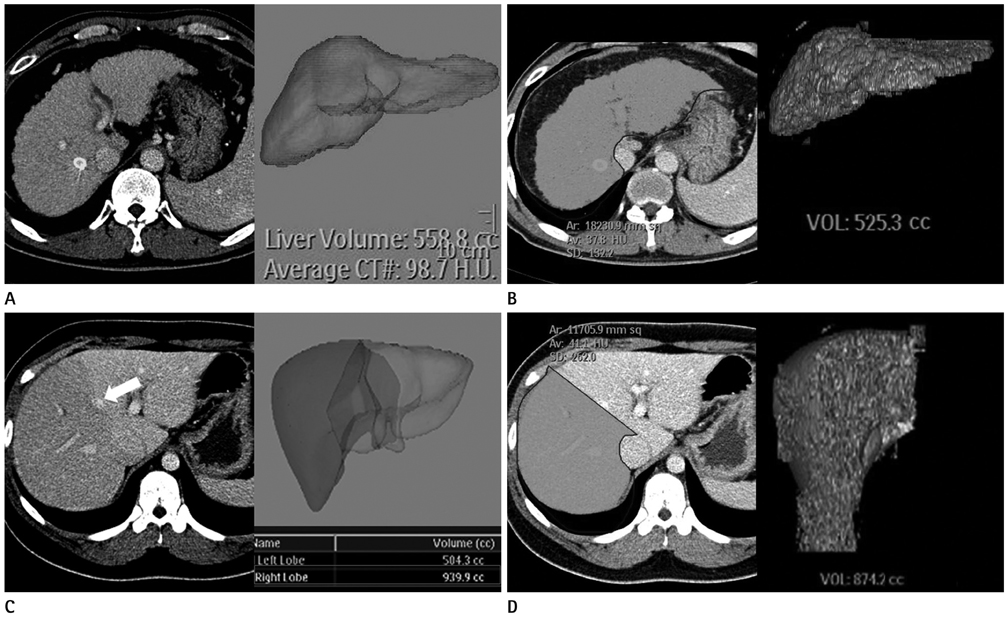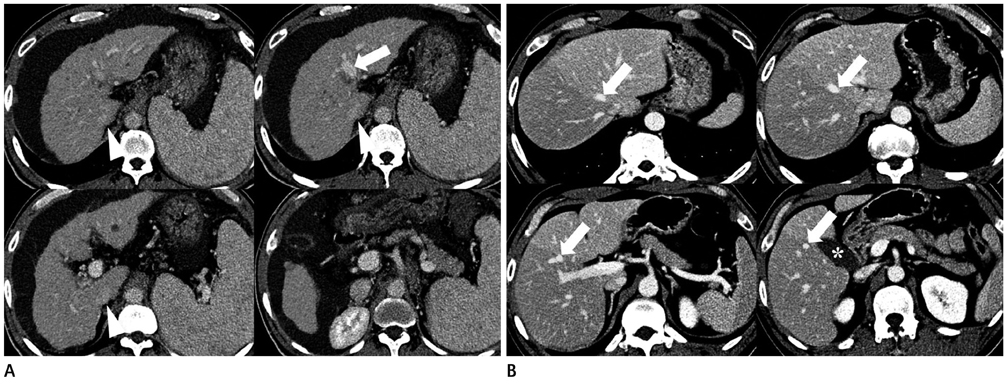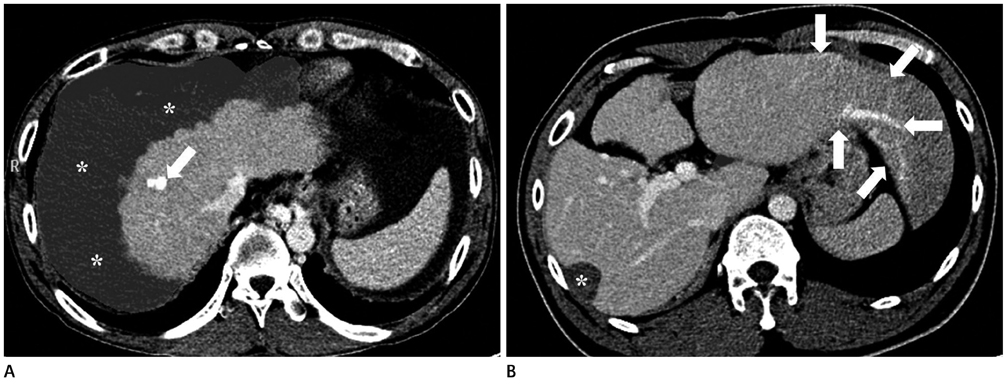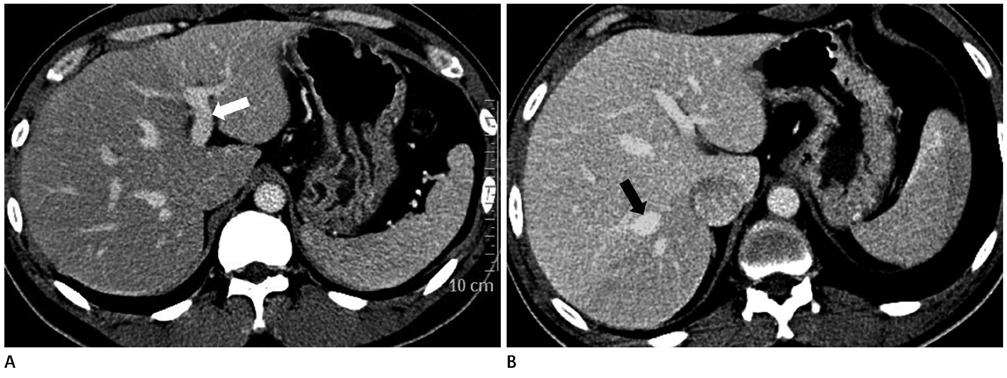J Korean Soc Radiol.
2013 Feb;68(2):125-136. 10.3348/jksr.2013.68.2.125.
Feasibility of Commercially Available, Fully Automated Hepatic CT Volumetry for Assessing Both Total and Territorial Liver Volumes in Liver Transplantation
- Affiliations
-
- 1Department of Radiology, Seoul National University Hospital, Seoul, Korea. shkim7071@gmail.com
- 2The Institute of Radiation Medicine, Seoul National University Hospital, Seoul, Korea.
- 3Department of Surgery, Seoul National University Hospital, Seoul, Korea.
- KMID: 2097990
- DOI: http://doi.org/10.3348/jksr.2013.68.2.125
Abstract
- PURPOSE
To assess the feasibility of commercially-available, fully automated hepatic CT volumetry for measuring both total and territorial liver volumes by comparing with interactive manual volumetry and measured ex-vivo liver volume.
MATERIALS AND METHODS
For the assessment of total and territorial liver volume, portal phase CT images of 77 recipients and 107 donors who donated right hemiliver were used. Liver volume was measured using both the fully automated and interactive manual methods with Advanced Liver Analysis(R) software. The quality of the automated segmentation was graded on a 4-point scale. Grading was performed by two radiologists in consensus. For the cases with excellent-to-good quality, the accuracy of automated volumetry was compared with interactive manual volumetry and measured ex-vivo liver volume which was converted from weight using analysis of variance test and Pearson's or Spearman correlation test. Processing time for both automated and interactive manual methods was also compared.
RESULTS
Excellent-to-good quality of automated segmentation for total liver and right hemiliver was achieved in 57.1% (44/77) and 17.8% (19/107), respectively. For both total and right hemiliver volumes, there were no significant differences among automated, manual, and ex-vivo volumes except between automate volume and manual volume of the total liver (p = 0.011). There were good correlations between automate volume and ex-vivo liver volume (gamma = 0.637 for total liver and gamma = 0.767 for right hemiliver). Both correlation coefficients were higher than those with manual method. Fully automated volumetry required significantly less time than interactive manual method (total liver: 48.6 sec vs. 53.2 sec, right hemiliver: 182 sec vs. 244.5 sec).
CONCLUSION
Fully automated hepatic CT volumetry is feasible and time-efficient for total liver volume measurement. However, its usefulness for territorial liver volumetry needs to be improved.
MeSH Terms
Figure
Reference
-
1. Strong RW, Lynch SV, Ong TH, Matsunami H, Koido Y, Balderson GA. Successful liver transplantation from a living donor to her son. N Engl J Med. 1990. 322:1505–1507.2. Broering DC, Sterneck M, Rogiers X. Living donor liver transplantation. J Hepatol. 2003. 38:Suppl 1. S119–S135.3. Ploeg RJ, D'Alessandro AM, Knechtle SJ, Stegall MD, Pirsch JD, Hoffmann RM, et al. Risk factors for primary dysfunction after liver transplantation--a multivariate analysis. Transplantation. 1993. 55:807–813.4. Kiuchi T, Kasahara M, Uryuhara K, Inomata Y, Uemoto S, Asonuma K, et al. Impact of graft size mismatching on graft prognosis in liver transplantation from living donors. Transplantation. 1999. 67:321–327.5. Fan ST, Lo CM, Liu CL, Yong BH, Chan JK, Ng IO. Safety of donors in live donor liver transplantation using right lobe grafts. Arch Surg. 2000. 135:336–340.6. Akabayashi A, Slingsby BT, Fujita M. The first donor death after living-related liver transplantation in Japan. Transplantation. 2004. 77:634.7. Vauthey JN, Abdalla EK, Doherty DA, Gertsch P, Fenstermacher MJ, Loyer EM, et al. Body surface area and body weight predict total liver volume in Western adults. Liver Transpl. 2002. 8:233–240.8. Sakamoto S, Uemoto S, Uryuhara K, Kim ID, Kiuchi T, Egawa H, et al. Graft size assessment and analysis of donors for living donor liver transplantation using right lobe. Transplantation. 2001. 71:1407–1413.9. Hermoye L, Laamari-Azjal I, Cao Z, Annet L, Lerut J, Dawant BM, et al. Liver segmentation in living liver transplant donors: comparison of semiautomatic and manual methods. Radiology. 2005. 234:171–178.10. Nakayama Y, Li Q, Katsuragawa S, Ikeda R, Hiai Y, Awai K, et al. Automated hepatic volumetry for living related liver transplantation at multisection CT. Radiology. 2006. 240:743–748.11. Suzuki K, Epstein ML, Kohlbrenner R, Garg S, Hori M, Oto A, et al. Quantitative radiology: automated CT liver volumetry compared with interactive volumetry and manual volumetry. AJR Am J Roentgenol. 2011. 197:W706–W712.12. Dubus L, Gayet M, Zappa M, Abaleo L, De Cooman A, Orieux G, et al. Comparison of semi-automated and manual methods to measure the volume of liver tumours on MDCT images. Eur Radiol. 2011. 21:996–1003.13. Henderson JM, Heymsfield SB, Horowitz J, Kutner MH. Measurement of liver and spleen volume by computed tomography. Assessment of reproducibility and changes found following a selective distal splenorenal shunt. Radiology. 1981. 141:525–527.14. Bae KT, Giger ML, Chen CT, Kahn CE Jr. Automatic segmentation of liver structure in CT images. Med Phys. 1993. 20:71–78.15. Okada T, Shimada R, Hori M, Nakamoto M, Chen YW, Nakamura H, et al. Automated segmentation of the liver from 3D CT images using probabilistic atlas and multilevel statistical shape model. Acad Radiol. 2008. 15:1390–1403.16. Kim KW, Lee J, Lee H, Jeong WK, Won HJ, Shin YM, et al. Right lobe estimated blood-free weight for living donor liver transplantation: accuracy of automated blood-free CT volumetry--preliminary results. Radiology. 2010. 256:433–440.17. Karlo C, Reiner CS, Stolzmann P, Breitenstein S, Marincek B, Weishaupt D, et al. CT- and MRI-based volumetry of resected liver specimen: comparison to intraoperative volume and weight measurements and calculation of conversion factors. Eur J Radiol. 2010. 75:e107–e111.18. Suzuki K, Kohlbrenner R, Epstein ML, Obajuluwa AM, Xu J, Hori M. Computer-aided measurement of liver volumes in CT by means of geodesic active contour segmentation coupled with level-set algorithms. Med Phys. 2010. 37:2159–2166.19. Gao L, Heath DG, Kuszyk BS, Fishman EK. Automatic liver segmentation technique for three-dimensional visualization of CT data. Radiology. 1996. 201:359–364.20. Heymsfield SB, Fulenwider T, Nordlinger B, Barlow R, Sones P, Kutner M. Accurate measurement of liver, kidney, and spleen volume and mass by computerized axial tomography. Ann Intern Med. 1979. 90:185–187.21. Kawasaki S, Makuuchi M, Matsunami H, Hashikura Y, Ikegami T, Chisuwa H, et al. Preoperative measurement of segmental liver volume of donors for living related liver transplantation. Hepatology. 1993. 18:1115–1120.22. Lemke AJ, Hosten N, Neumann K, Müller B, Neuhaus P, Felix R, et al. [CT volumetry of the liver before transplantation]. Rofo. 1997. 166:18–23.23. Sandrasegaran K, Kwo PW, DiGirolamo D, Stockberger SM Jr, Cummings OW, Kopecky KK. Measurement of liver volume using spiral CT and the curved line and cubic spline algorithms: reproducibility and interobserver variation. Abdom Imaging. 1999. 24:61–65.24. Hiroshige S, Shimada M, Harada N, Shiotani S, Ninomiya M, Minagawa R, et al. Accurate preoperative estimation of liver-graft volumetry using three-dimensional computed tomography. Transplantation. 2003. 75:1561–1564.25. Gondolesi GE, Yoshizumi T, Bodian C, Kim-Schluger L, Schiano T, Fishbein T, et al. Accurate method for clinical assessment of right lobe liver weight in adult living-related liver transplant. Transplant Proc. 2004. 36:1429–1433.
- Full Text Links
- Actions
-
Cited
- CITED
-
- Close
- Share
- Similar articles
-
- Clinical implication of hepatic volumetry for living donor liver transplantation
- Factors Influencing Liver and Spleen Volume Changes after Donor Hepatectomy for Living Donor Liver Transplantation
- Calculation of Standard Liver Volume of Korean Adults
- The role of computed tomography volumetry of the liver with subsequent three-dimensional modeling in the planning of the operation
- Resection plane-dependent error in computed tomography volumetry of the right hepatic lobe in living liver donors





